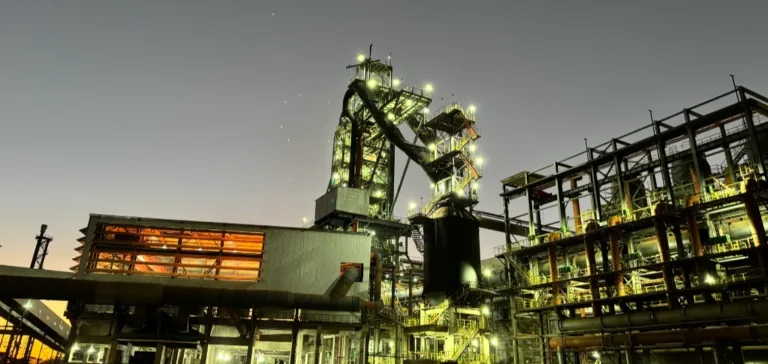Chinese group Tsingshan Holding, the world’s largest producer of nickel and stainless steel, has signed an $800 million agreement to expand the Manhize steel plant, operated by its subsidiary Dinson Iron and Steel Company (DISCO). This investment aims to double annual carbon steel production capacity from 600,000 to 1.2 million tons. But beyond steelmaking, the agreement profoundly reshapes Zimbabwe’s energy market. Each ton of steel produced requires massive electricity consumption, which now places Manhize at the center of the country’s supply balance. The ramp-up of the steel plant means a rapid and sustained increase in electricity demand, forcing authorities to rethink distribution between industrial production, domestic consumption, and regional exports.
The site’s first phase had already required the construction of a 50 MW thermal power plant, directly integrated into the complex. Currently, only 24 MW are used by the operating facilities, while the plant can theoretically inject a surplus into the national grid. In addition, a cogeneration system recovers hot gases from the blast furnaces, covering about 20% of internal needs. However, with the signed agreement and planned expansion, consumption could exceed 500 MW at full capacity, a considerable threshold in a country where national installed capacity must still reach the 2,500 MW target by 2025. The steel plant therefore positions itself not only as a major consumer but also as a strategic player in the electricity system.
An agreement linking industry and energy
The investment agreement goes beyond steel. Tsingshan included the construction of new energy infrastructure to support the plant’s growth. The project notably provides for a wind farm on the Manhize ridges, where a site has already been identified and feasibility studies are underway. A hydroelectric dam is also planned within the industrial park to secure supply in addition to coal. These initiatives reflect a strategic shift: industrial expansion is inseparable from energy diversification. In this sense, the agreement positions Manhize as a catalyst for innovation in Zimbabwe’s electricity sector.
The potential impact goes beyond the site’s local needs. Zimbabwean authorities have already mentioned the possibility for DISCO to inject part of its surplus electricity production into the national grid, thus becoming an independent power producer. If this scenario is confirmed, it would profoundly alter the structure of the electricity market by introducing new competition to the state-owned Zimbabwe Electricity Supply Authority (ZESA). It would also raise regulatory challenges: arbitrating between electricity destined for heavy industry, domestic consumption, and regional export projects. The Tsingshan agreement thus becomes a key issue not only for the steel industry but also for the country’s energy governance.
Consequences for national infrastructure
The pressure induced by this agreement reverberates on the planning of major national energy infrastructures. Zimbabwe, already facing chronic power shortages, recently inaugurated the expansion of the Hwange thermal power station, carried out by Sinohydro and financed by Eximbank China for $1.5 billion. This expansion added 600 MW to the national grid, bringing the site’s total capacity to 1,520 MW. While this improvement has helped ease supply deficits, Manhize’s ramp-up will quickly absorb a significant portion of this gain. The government will therefore have to accelerate diversification of the energy mix and invest in other projects to maintain the balance between supply and demand.
The Tsingshan agreement thus fits into a broader dynamic where industry and energy advance hand in hand. By targeting 2,500 MW of installed capacity by 2025, Harare places energy stability at the core of its development agenda. Yet, the new demand generated by the steel plant could force authorities to review their timetable, strengthen regional interconnections (notably with Mozambique and Zambia), and arbitrate more strictly between industrial and residential priorities. This growing interdependence shows how an industrial agreement can become a determining factor in national energy policy.
A lever for energy and mining diversification
The agreement should not be analyzed in isolation. It adds to a series of foreign investments that directly link mining resources and energy infrastructure. In lithium, Zimbabwe signed an agreement with two Chinese partners to build a $270 million concentrator at Sandawana, capable of processing 600,000 tons per year by 2027. In hydrocarbons, Australian company Invictus Energy is conducting exploration at Muzarabani, a project recognized as being of “National Interest” by the government in 2025, with drilling aimed at identifying gas or oil reserves. These projects, combined with Manhize, reinforce the need for a robust and diversified electricity network.
Tsingshan is not limited to steel: the group also controls assets in ferrochrome, coking coal, and lithium, consolidating its central role in Zimbabwe’s energy and industrial chain. The $800 million agreement illustrates this integrated logic, where a major industrial investment drives a recomposition of energy, financial, and diplomatic balances. For Harare, the issue is no longer only producing more steel or electricity, but managing a new energy balance of power created by the implantation of foreign giants in its strategic infrastructure.






















